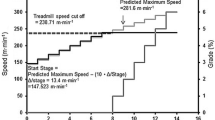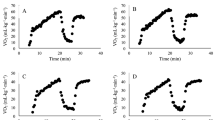Abstract
Purpose
Graded exercise testing (GXTs) is used to determine maximum oxygen uptake (\(\dot{V}{\text{O}}_{{2\max }}\)). Recently, customized submaximal exercise testing (CSET) completed on both treadmill and cycle ergometry were validated.
Methods
Interrater reliability of the CSET for cycle ergometry was examined. Thirteen participants (age 31 ± 10.2 y, weight 77.9 ± 10.5 kg, height 176.2 ± 9.9 cm, body mass index 25.1 ± 2.9) completed the 2-stage × 3-min CSET protocol performed by two separate testers. True \(\dot{V}{\text{O}}_{2\mathrm{max}}\) was determined using the highest value derived by a GXT and verification bout. Skeletal muscle oxygen saturation (\(\dot{S}m{O}_{2}\)), measured using near-infrared spectrometry on the medial gastrocnemius muscle, and \(\dot{V}{\text{O}}_{2}\) were monitored during each CSET; whereby, \(\dot{V}{\text{O}}_{2}\) kinetics were modeled breath-by-breath data for each 3-min stage. Measurement agreement was quantified using intraclass coefficient (ICC), typical error (TE), and coefficient of variation (CV).
Results
“True” \(\dot{V}{\text{O}}_{2\mathrm{max}}\) (ml·kg−1·min−1) between the GXT (41.3 ± 10.5) and verification (42.5 ± 11.5) was established (ICC = 0.98, TE: 0.98, CV 2.1%). Estimated \(\dot{V}{\text{O}}_{2\mathrm{max}}\) by tester 1 (42.5 ± 9.8) and tester 2 (42.7 ± 8.9) did not differ from “true” \(\dot{V}{\text{O}}_{2\mathrm{max}}\) (F2,36 = 0.02, p = 0.98, ηp2 = 0.00). The second stage evoked a \(\dot{V}{\text{O}}_{2}\) slow component of 194 ± 124 ml·min−1 that corresponded with a time-dependent decline of \(\dot{S}m{O}_{2}\). The mean \(\dot{S}m{O}_{2}\) from the two CSET testers were highly correlated (ICC = 0.91, TE: 4.1%, CV = 8.9%).
Conclusions
The CSET is a reliable and valid procedure and \(\dot{S}m{O}_{2}\) is a useful tool for corroborating the second stage is in the heavy-intensity domain.



Similar content being viewed by others
Abbreviations
- BMI:
-
Body mass index
- CP:
-
Critical power
- CSET:
-
Customized submaximal exercise test
- CRF:
-
Cardio-respiratory fitness
- CV:
-
Coefficient of variation
- GET:
-
Gas exchange threshold
- GXT:
-
Graded exercise test
- ICC:
-
Intraclass coefficient
- NIRS:
-
Near-infrared spectrometry
- \(\dot{S}m{O}_{2}\) :
-
Skeletal muscle oxygen saturation
- TE:
-
Typical error
- \(\dot{V}{\text{O}}_{2}\) :
-
Volume of oxygen uptake
- \(\dot{V}{\text{O}}_{2max}\) :
-
Maximum oxygen uptake
- W peak :
-
Power output evoking \(\dot{V}{\text{O}}_{2}\)
References
Bangalore S, Sawhney S, Messerli FH (2008) Relation of beta-blocker-induced heart rate lowering and cardioprotection in hypertension. J Am Coll Cardiol 52(18):1482–1489. https://doi.org/10.1016/j.jacc.2008.06.048
Barstow TJ (2019) Understanding near infrared spectroscopy and its application to skeletal muscle research. J Appl Physiol 126(5):1360–1376. https://doi.org/10.1152/japplphysiol.00166.2018
Bland JM, Altman DG (1986) Statistical methods for assessing agreement between two methods of clinical measurement. Lancet 1(8476):307–310
Bruce RA, Kusumi F, Hosmer D (1973) Maximal oxygen intake and nomographic assessment of functional aerobic impairment in cardiovascular disease. Am Heart J 85(4):546–562
Burnley M, Jones AM (2007) Oxygen uptake kinetics as determinant of sports performance. Eur J Sport Sci 7(2):63–79
Farrell SW, Fitzgerald SJ, McAuley PA, Barlow CE (2010) Cardiorespiratory fitness, adiposity, and all-cause mortality in women. Med Sci Sports Exerc 42(11):2006–2012. https://doi.org/10.1249/MSS.0b013e3181df12bf
Formenti F, Dockerill C, Kankanange L, Zhang L, Takaishi T, Ishida K (2019) The effect of pedaling cadence on skeletal muscle oxygenation during cycling at moderate exercise intensity. Int J Sports Med. https://doi.org/10.1055/a-0835-6286
Glaister M, Gissane C (2018) Caffeine and physiological responses to submaximal exercise: a meta-analysis. Int J Sports Physiol Perform 13(4):402–411. https://doi.org/10.1123/ijspp.2017-0312
Guazzi M, Bandera F, Ozemek C, Systrom D, Arena R (2017) Cardiopulmonary exercise testing: what is its value? J Am Coll Cardiol 70(13):1618–1636. https://doi.org/10.1016/j.jacc.2017.08.012
Hopkins WG (2000) Measures of reliability in sports medicine and science. Sports Med 30(1):1–15
Jamnick NA, By S, Pettitt CD, Pettitt RW (2016) Comparison of the YMCA and a custom submaximal exercise test for determining VO2max. Med Sci Sports Exerc 48(2):254–259. https://doi.org/10.1249/mss.0000000000000763
Kirkeberg JM, Dalleck LC, Kamphoff CS, Pettitt RW (2011) Validity of 3 protocols for verifying VO2max. Int J Sports Med 32:266–270. https://doi.org/10.1055/s-0030-1269914
Kodama S, Saito K, Tanaka S, Maki M, Yachi Y, Asumi M, Sugawara A, Totsuka K, Shimano H, Ohashi Y, Yamada N, Sone H (2009) Cardiorespiratory fitness as a quantitative predictor of all-cause mortality and cardiovascular events in healthy men and women: a meta-analysis. JAMA 301(19):2024–2035. https://doi.org/10.1001/jama.2009.681
Lee DC, Sui X, Artero EG, Lee IM, Church TS, McAuley PA, Stanford FC, Kohl HW 3rd, Blair SN (2011) Long-term effects of changes in cardiorespiratory fitness and body mass index on all-cause and cardiovascular disease mortality in men: the aerobics center longitudinal study. Circulation 124(23):2483–2490
Liguori G (2021) ACSM’s Guidelines for Exercise Testing and Prescription, 11th edn. Wolters Kluwer Health, Philadelphia
Londeree BR, Moffitt-Gerstenberger J, Padfield JA, Lottmann D (1997) Oxygen consumption of cycle ergometry is nonlinearly related to work rate and pedal rate. Med Sci Sports Exerc 29(6):775–780
McClaran SR, Wetter TJ (2007) Low does of caffeine reduce heart rate during submaximal cycle ergometry. J Int Soc Sports Nutr 4:11
Midgley AW, McNaughton LR, Polman R, Marchant D (2007) Criteria for determination of maximal oxygen uptake: a brief critique and recommendations for future research. Sports Med 37(12):1019–1028
Noonan V, Dean E (2000) Submaximal exercise testing: clinical application and interpretation. Phys Ther 80(8):782–807
Pettitt RW, Symons JD, Taylor JE, Eisenman PE, White AT (2008) Adjustment for gas exchange threshold enhances precision of heart rate-derived VO2 estimates during heavy exercise. Appl Physiol Nutr Metab 33:68–74
Pettitt RW, Clark IE, Ebner SM, Sedgeman DT, Murray SR (2013) Gas exchange threshold and VO2max testing for athletes: an update. J Strength Cond Res 27(2):549–555. https://doi.org/10.1519/JSC.0b013e31825770d7
Poole DC (1994) Role of exercising muscle in slow component of VO2. Med Sci Sports Exerc 26(11):1335–1340
Poole DC, Jones AM (2012) Oxygen uptake kinetics. Compr Physiol 2:933–996
Sawyer BJ, McMahon N, Thornhill KL, Baughman BR, Mahoney JM, Pattison KL, Freeberg KA, Botts RT (2020) Supra-versus submaximal cycle ergometer verification of VO(2max) in males and females. Sports (basel). https://doi.org/10.3390/sports8120163
Sedgeman DT, Dalleck LC, Clark IE, Jamnick N, Pettitt RW (2013) Analysis of submaximal and supramaximal square-wave bouts for consistently verifying “true” maximal oxygen uptake. Int J Sports Med 34:1058–1062
Shastri L, Alkhalil M, Forbes C, El-Wadi T, Rafferty G, Ishida K, Formenti F (2019) Skeletal muscle oxygenation during cycling at different power output and cadence. Physiol Rep 7(3):e13963. https://doi.org/10.14814/phy2.13963
Strom CJ, Pettitt RW, Krynski LM, Jamnick NA, Hein CJ, Pettitt CD (2018) Validity of a customized submaximal treadmill protocol for determining VO(2max). Eur J Appl Physiol 118(9):1781–1787. https://doi.org/10.1007/s00421-018-3908-x
Takagi S, Murase N, Kime R, Niwayama M, Osada T, Katsumura T (2016) Muscle oxygen dynamics during cycling exercise in angina pectoris patients. Adv Exp Med Biol 923:291–297. https://doi.org/10.1007/978-3-319-38810-6_39
Zoladz JA, Rademaker AC, Sargeant AJ (1995) Non-linear relationship between O2 uptake and power output at high intensities of exercise in humans. J Physiol 488(Pt 1):211–217
Acknowledgements
Michael Kantor received an internal research grant from Rocky Mountain University of Health Professions to support this study. The results of this study are presented clearly, honestly and without fabrication, falsification or inappropriate data manipulation.
Author information
Authors and Affiliations
Contributions
MK, SF, CG, and RP conceived and designed research. MK and CG conducted experiments. MK contributed to modeling of the raw data. MK, SF, CG, MK, and RWP wrote the manuscript. All authors read and approved the manuscript.
Corresponding author
Ethics declarations
Conflict of interest
The authors declare no conflicts of interest.
Additional information
Communicated by Philip D. Chilibeck.
Publisher's Note
Springer Nature remains neutral with regard to jurisdictional claims in published maps and institutional affiliations.
Rights and permissions
Springer Nature or its licensor holds exclusive rights to this article under a publishing agreement with the author(s) or other rightsholder(s); author self-archiving of the accepted manuscript version of this article is solely governed by the terms of such publishing agreement and applicable law.
About this article
Cite this article
Kantor, M.A., Fretti, S., Gubler, C. et al. Interrater reliability of a customized submaximal cycle ergometer test. Eur J Appl Physiol 123, 43–48 (2023). https://doi.org/10.1007/s00421-022-05052-9
Received:
Accepted:
Published:
Issue Date:
DOI: https://doi.org/10.1007/s00421-022-05052-9




